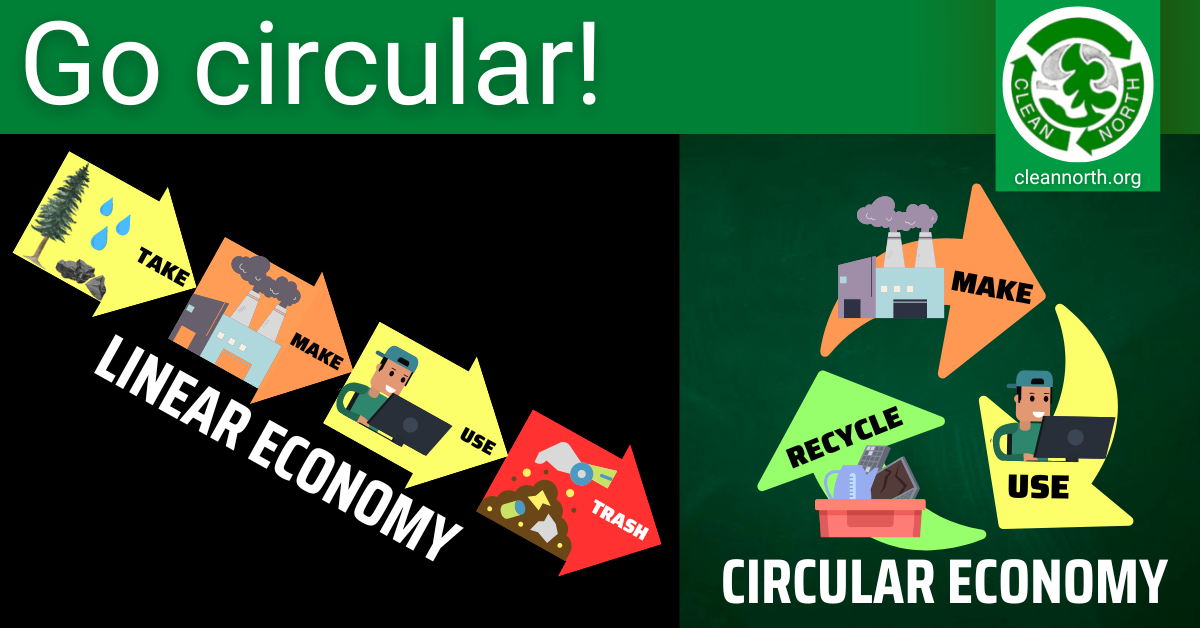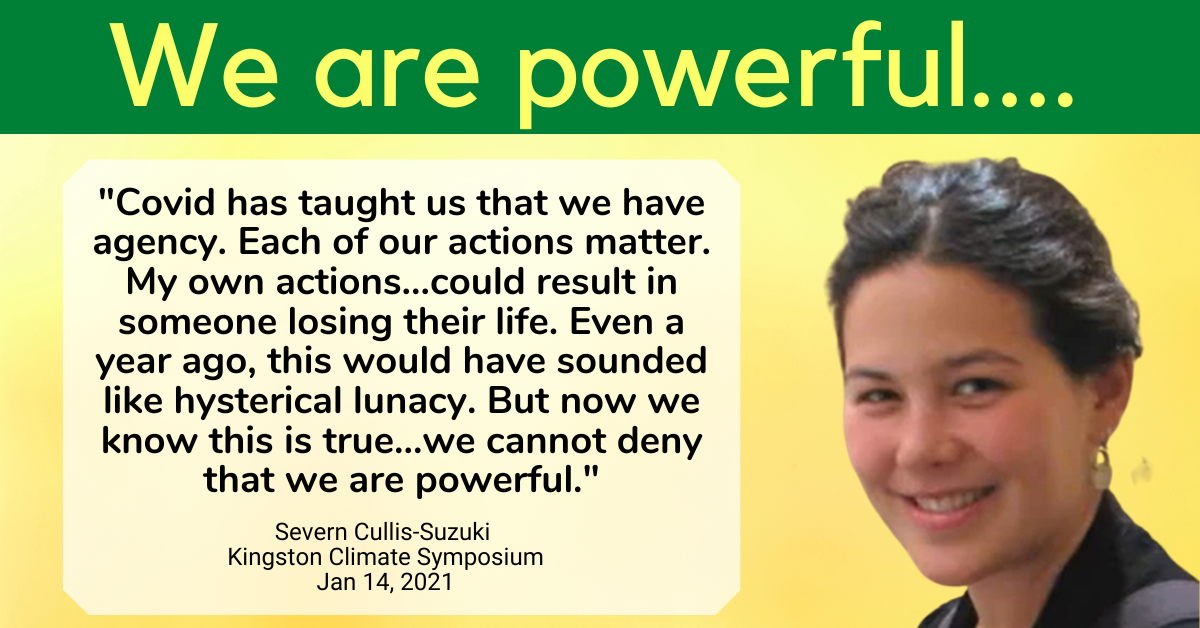
Since it’s Circular Economy Month, we are going to tell you what a circular economy is and why we should all embrace it. The traditional process of extracting raw materials, making them into products, and tossing them away at the end of their useful life is no longer acceptable. Here’s why: It takes a lot of energy and raw materials to make stuff like buildings, cars, furniture, computers, and other products. And those are finite resources! Plus we have a big climate change problem—we can’t keep using massive amounts of fossil fuels to make things. Climate change is here and already affecting people, ecosystems and the economy. So now interior designers like Sheri Tuck of Ergo Office Plus, a Sault-based design firm, are choosing to work within and towards a circular economy to help protect ecosystems, people, and the economy and help fight climate change. We thank Sheri for providing most of the information in this post!
And FYI, we offer up tips for how you can go circular at home near this end of this post.
What is a linear economy?
The traditional production model involves taking materials such as trees, minerals, and water from the Earth, making products from them, and then throwing them away as waste. The process is linear. It goes in a straight line. It’s incredibly wasteful and very hard on the environment with significant impacts on human health, too (for example, toxic chemicals/heavy metals from e-waste leaching from landfills into ground water).
What is a circular economy?
The circular economy is based on the below three principles, driven by intelligent design:
- Cutting out waste and pollution
- Reusing products and materials at their maximum value
- Regenerating nature
One example of a circular innovation is engineering how to remove valuable raw materials, metals, polymers, and alloys from discarded products to use in new products.
Sheri notes, “We interior designers want people to understand that a design project is more than an aesthetic challenge! The sustainability programs that we work under— such as LEED and WELL—consider so much more—for example air and water quality as well as access to public transportation to minimize emissions from traffic.”
Practices that reduce waste and pollution
First, designers can specify that companies use local extraction and manufacturing processes (optimally, within 800 kilometres of the project).
In addition, they can design/make use of modular components that can be scaled up or down easily with little waste created. Modular components by nature result in less construction waste, and it’s easier to take things apart and re-use them when changes are needed. For example, modular walls and furniture fit a wider variety of spaces and can be reconfigured more easily.
Another way design firms practice circular thinking is by working with clients to manage and re-deploy furniture inventory as efficiently as possible—to perhaps sell it or donate it to a charity to extend its useful life.
The role of environmental product declarations
Fortunately many manufacturers are taking a hard look at how they make stuff to ensure they most efficient use of raw materials, use less energy, create less waste, and allow them to reuse waste materials in new and innovative ways. One way designers can find these innovators is through Environmental Product Declarations or EPDs. These are similar to nutrition labels on food only they reveal what a product is made of and how it affects the environment across its entire life cycle. These declarations help designers assess products based on their environmental footprint including minimizing waste, pollution, and greenhouse-gas-related emissions over time.
Working with contractors
Moving from designing to building, designers can request waste management plans from contractors ensure products are actually being recycled or reused as the project plans called for.
“Collaboration among the manufacturer, designer and contractor to minimize construction waste is critical to ensuring circularity,” Sheri notes. “Designers can integrate information between building material suppliers and contractors to ensure materials are taken apart and reused rather than ending up in the landfill.
“The key is to design for durability, reuse, remanufacturing and recycling to keep products circulating within the economy.”
For example, her firm specifies carpet tile products that can be installed or replaced in modular sections, resulting in less cutting-related waste and making it easier to replace damaged or stained areas. Sheri notes that many carpet tile manufacturers now take back carpet tiles and use them to make new products. Interface Carpet takes old fishing nets and makes them into carpet fibres. Another company, Kirei, has created an acoustic ceiling baffle made from Nike end-of-life footwear and plastic water bottles. And in fact, acoustic ceiling tiles can be recycled to create new ones made from 100% post-consumer material.
After the work is complete, designers can also help those managing facilities to ensure building systems are running as designers intended and that products are being maintained according to manufacturer specifications to ensure a longer life.
“It’s not just about new builds, either,” Sheri says. “Those managing existing buildings can make a large impact on sustainability through their purchasing, maintenance, waste diversion, and recycling policies and practices. Part of our role is to educate and advocate to clients and facility managers to encourage sustainable processes and a circular economy as part of their everyday business.”
How can you embrace circular economy principles at home?

- Respect nature and all the goods and services it provides us, and understand how unnecessary waste harms people, ecosystems, and the economy.
- Research — take time to find out what’s truly a green choice and what’s not. Challenge your assumptions. Look for evidence of sustainability.
- Replant unused land in trees (to store carbon) or gardens (to feed people).
- Replenish our soils with nutrients, our water with fish, our forests with trees.
- Reduce what you buy, especially things that result in unnecessary waste or harm the environment…go minimalist; pause before you click Order; share or rent tools!
- Return items you don’t really need. Stop and think before you open the package!
- Refuse items that are single use, overpackaged, plastic, toxic, or greenwashed (green marketing spin).
- Reuse/repurpose — shop secondhand first; give unwanted stuff a second life (surplus construction materials, day-old bread, imperfect fruit, yogurt tubs, meat bones into stock, tablecloths into produce bags, etc.).
- Repair — Youtube is an amazing free resource for how to fix it yourself!
- Regift unwanted or gently used items to others.
- Rot — compost as much organic waste (produce scraps, paper, cotton balls, etc.) as possible.
- Recycle right — learn local recycling rules and follow them.
- Rubbish! Only as a last resort, throw things away.
And finally…take a page from interior designers’ books and PLAN for circularity! Build it into everything you do—especially building and renovation projects.




